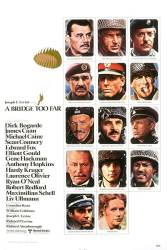Corrected entry: Toward the end of the movie, the German soldiers are seen from behind crossing a footbridge to take the British soldiers prisoner at the Hartenstine Hotel. The rifles the Germans are carrying are American M1's, not the Mausers that most German infantry were issued.
Corrected entry: During the fighting in Arnhem, the man and his son are piling up bodies. They pick up a dead girl and lay her on the pile with her legs hanging off to the right. The father immediately goes to help some other people, the son screams "Father!" and the father rushes over to his dead son. In the background, the dead girl's legs are now hanging off to the left.
Correction: The girl's legs are still in the same position, it's the camera that has moved position (approximately 100-120° counterclockwise), creating the illusion that her legs are now going left instead of right.
Corrected entry: The British PIAT anti-tank weapon could not be readied for the first shot as quickly as shown in the movie. It was not a rocket launcher like the US Bazooka, but rather a bomb launcher; the gunner had to use his entire strength, and his hands and legs, to cock it for the first shot, because the firing pin spring in the weapon was very strong. For subsequent shots, the force of the propellant charge would do the work.
Correction: PIAT (Projectile Infantry Anti Tank) had to be physically reset after each round was fired. As previously stated the launcher had to be reset by use of the whole body usually standing up. Therefore the firer in this scene would have cocked the weapon under cover from enemy fire/view (prior to the scene opening). Due to the chamber of this weapon being open topped the round/missile would not had been loaded until the firer was ready in his fire position if the weapon was moved whilst loaded the round could have fallen out. The projectile had no propellant so there was no gas to build up in the weapon to allow the working parts to reset. The launcher was simply a large spring that ejected the round/missile in to the air; the round flew so slowly it could be seen flying towards the target just like the scene suggests. Unlike a bazooka or modern launcher the projectile had no propellant (like a rocket) to power itself through the air therefore there was no firing pin in the launcher. The scene doesn't show the whole process of loading and firing a PIAT subsequently putting doubt into viewer's minds how accurate the scene is.
Corrected entry: One major inaccuracy in the film was apparently intentional. The Nijmegen bridge, captured by Robert Redford in the film, was in reality stormed by British grenadiers. Producer Joseph E. Levine, who had largely financed the film with his own money, claimed that "having Redford win the battle was better box office".
Correction: On 20 September 1944, the 82nd Airborne Divisions 505th PIR launched an attack through Nijmegen to capture the (near) south end of the bridge over the Waal River, joined by British Grenadiers. The 82nd 504th PIR, with C CO. 307th Engineers, launched a simultaneous attack across the river to capture the north end of the bridge. A Battalion of 504th PIR led by Major Julian Cook did assualt the Nijmegen Bridge by crossing the Waal river to the north (far) bank. Gen. Horrocks British armor supported the attacks. As the 504th captured the far end of the bridge Gen. Horrock ordered tanks to cross.






Correction: But in the last year of the war many Germans were using captured weapons, so this is plausible.
JEREMY BENJAMIN